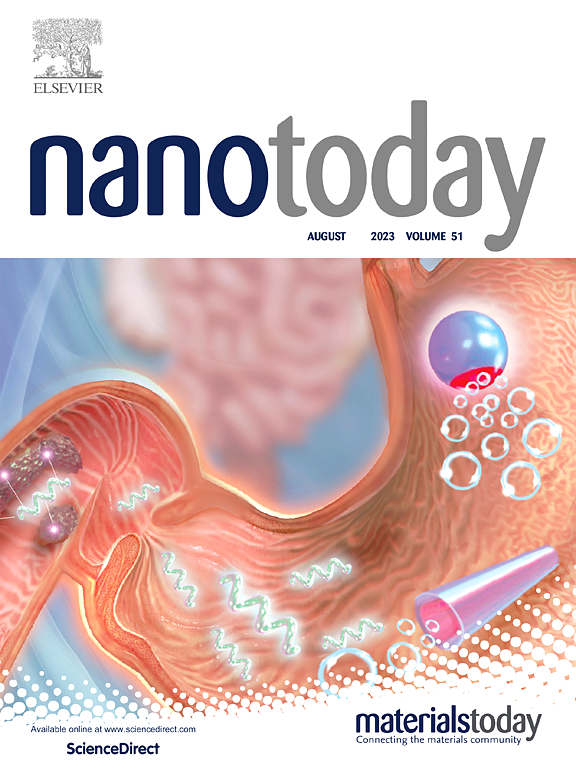声动力可生物降解的伪共轭聚合物递送华法林诱导癌变ROS的产生和铁下垂
IF 10.9
1区 材料科学
Q1 CHEMISTRY, MULTIDISCIPLINARY
引用次数: 0
摘要
肝细胞癌(HCC)是最常见的原发性肝癌类型,其特点是免疫应答率低,复发率高。这强调了对肝癌患者更有效的治疗策略的迫切需要。铁下垂是一种与铁依赖性脂质过氧化相关的细胞死亡,在HCC治疗中显示出巨大的潜力。然而,这种单一疗法对肿瘤的治疗效果仍然有限。通过抑制肿瘤细胞抗氧化系统促进活性氧(ROS)的积累和脂质过氧化形成已成为一种很有前景的抗肿瘤策略。在这项研究中,我们开发了一种纳米平台NP(纳米颗粒)-BSD@WFR,专门用于HCC治疗。该系统结合了可生物降解的声动力聚合物(BSD)和华法林(WFR),华法林是一种VKORC1L1抑制剂,可防止细胞内过氧化物消除并增强铁凋亡。在超声照射下,NP-BSD@WFR产生ROS,释放WFR,直接靶向癌细胞。同时,ROS和WFR协同增强癌细胞中脂质过氧化产物,引发铁下垂,激活免疫系统。动物研究进一步表明,声动力治疗与wfr诱导的铁下垂联合治疗可产生协同抗肿瘤作用,促进体内强烈的免疫应答。本研究介绍了一种结合声动力疗法和白细胞fr治疗HCC的创新治疗方法,并强调了其良好的疗效。本文章由计算机程序翻译,如有差异,请以英文原文为准。
Sonodynamic biodegradable pseduo-conjugate polymer delivery of warfarin for inducing generation of cancerous ROS and ferroptosis
Hepatocellular carcinoma (HCC) is the most common type of primary liver cancer, characterized by low immune response rates and high recurrence. This underscores an urgent need for more effective treatment strategies for liver cancer patients. Ferroptosis, a type of cell death associated with iron-dependent lipid peroxidation, has shown significant potential in HCC treatment. However, the efficacy of this monotherapy for tumor treatment remains limited. Enhancing reactive oxygen species (ROS) accumulation and lipid peroxide formation by inhibiting the tumor cell antioxidant system has emerged as a promising anti-tumor strategy. In this study, we developed a nanoplatform, NP (nanoparticle)-BSD@WFR, specifically tailored for HCC treatment. This system combines a biodegradable sonodynamic polymer (BSD) with warfarin (WFR), a VKORC1L1 inhibitor that prevents intracellular peroxide elimination and enhances ferroptosis. Under ultrasound irradiation, NP-BSD@WFR generates ROS and releases WFR, directly targeting cancer cells. Concurrently, ROS and WFR synergistically enhance lipid peroxide production in cancer cells, triggering ferroptosis and activating the immune system. Animal studies further demonstrate that combining sonodynamic therapy with WFR-induced ferroptosis produces a synergistic anti-tumor effect, promoting a strong immune response in vivo. This study introduces an innovative therapeutic approach combining sonodynamic therapy and WFR for HCC treatment and highlights its promising efficacy.
求助全文
通过发布文献求助,成功后即可免费获取论文全文。
去求助
来源期刊

Nano Today
工程技术-材料科学:综合
CiteScore
21.50
自引率
3.40%
发文量
305
审稿时长
40 days
期刊介绍:
Nano Today is a journal dedicated to publishing influential and innovative work in the field of nanoscience and technology. It covers a wide range of subject areas including biomaterials, materials chemistry, materials science, chemistry, bioengineering, biochemistry, genetics and molecular biology, engineering, and nanotechnology. The journal considers articles that inform readers about the latest research, breakthroughs, and topical issues in these fields. It provides comprehensive coverage through a mixture of peer-reviewed articles, research news, and information on key developments. Nano Today is abstracted and indexed in Science Citation Index, Ei Compendex, Embase, Scopus, and INSPEC.
 求助内容:
求助内容: 应助结果提醒方式:
应助结果提醒方式:


